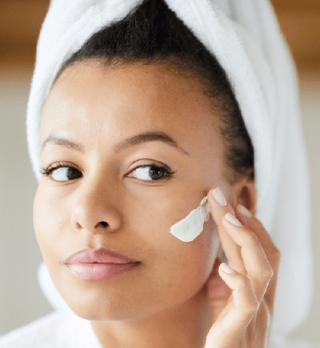If the skin on your face and/or body feels rough, flaky, and textured, then you probably have dry skin. Dry skin occurs due to a lack of moisture from water and natural oils in the skin; they required for your skin to maintain its softness and elasticity.
While dry skin can sometimes be linked to side effects from medication or an underlying illness, it can affect people of all ages, with or without underlying conditions.
The term “dry skin” is a skin type. You may have dry skin when your skin’s sebaceous glands don’t regularly produce enough natural oils. It can show on your complexion as scaliness and white flakes, with possible redness and irritation.
Signs and symptoms of dry skin
Cracks, flakes , and rough texture
If your skin feels bumpy and rough to the touch, it’s often a clear indication of dry skin since dryness is caused by a lack of moisture. As skin cracks, it begins to flake and the dead, dry skin cells fall off to be replaced by fresh, new cells. This natural, cyclical process is called desquamation.
More noticeable fine lines
If you have dry skin, you’re more likely to notice visible fine lines in your complexion. This is because dry skin has less elasticity, which can have an overall aging appearance on the surface of the skin.
Itchiness
As skin flakes away, patches of dead skin can remain on the surface, causing you a tingling or ticklish feeling. However, scratching dry skin can lead to infection and scarring. It’s best to treat the itch in other ways; they include using a richer moisturizer for dry skin and dry-brushing to lightly brush away dead skin.
Causes of dry skin
Environmental factors
Your daily living conditions and the weather affect your skin, so it’s often helpful to pay attention to the quality of the air where you live and work. Dry skin in the winter is very common in colder climates. Cold, dry air can dehydrate and parch the skin. Running the heat at home can dry out your skin even further.
Dehydration
Dehydrated skin can lead to dryness, so it’s important to keep hydrated by drinking plenty of water, especially in the summer months. As a general rule, you should drink one ounce of water for every pound in body weight. If you weigh 150 lbs., aim to drink 150 oz. of water throughout your day.
Moisturizing your face can also help to keep your skin optimally hydrated.
Menopause
Menopause can bring on a range of symptoms, from hot flashes and night sweats to a sharp decline in the production of estrogen. Estrogen stimulates the formation of skin-smoothing collagen and oils, meaning that when its production diminishes, it's common to experience dry, itchy skin.
Eczema
Eczema is a skin condition that causes itchy and inflamed dry skin, and can be triggered by weather changes, pollen, pollution or exposure to certain chemicals or ingredients.
Medication
Side effects of certain medications such as blood pressure drugs, cholesterol medications, acne treatments, wrinkle creams, and antihistamines can cause dry skin when taken long-term.
How to prevent dry skin
Identify the cause
When treating your dry skin, the first thing to do is to figure out what is causing it. Sometimes, it may be as simple as asking your doctor to switch the medication you’re on or drinking more water. Once the cause is identified, you can then begin to make some changes.
Use warm rather than hot water
While a steaming hot bath or shower can feel good, it’s not the best for your skin. The hotter the water is, the more oil and moisture is removed from your skin, so it’s better to take shorter, lukewarm showers.
Eat food rich in essential fatty acids
Foods such as salmon, walnuts and eggs help stimulate oil production in your skin cells. So, consider incorporating these essential fatty acids into your daily diet to improve any signs of dryness in your skin.
Follow a skincare regimen
Tailoring your skincare routine to your skin type and personal skin concerns will help to prevent dry skin, while keeping your skin feeling plump and moisturized. Look at our step-by-step regimen below.
Dry skin regimen
1.Cleanse
Begin with a cleanser to remove any impurities or dead cells from the surface of your skin, so that you have a clean base for applying the rest of the skincare products in your regimen.
2. Apply eye cream
Next, use an eye cream like our Hydrate & Plump Eye Cream to hydrate and re-plump the delicate skin around your eyes.
3. Use a serum
Allow a minute or two for your eye cream to soak in before using a serum. Consider our Hydrate & Plump Serum Capsules to smooth, plump and boost your skin’s hydration. Apply the serum using a light tapping motion with your fingertips.
4. Apply moisturizer
Once the serum has been absorbed into the skin, apply a moisturizer like our Max Daily Hydration Cream to leave the skin feeling moisturized and deeply hydrated for 24 hours.
5. SPF
To protect your skin from UV rays, finish with an SPF product and you’re good to go.
At night
At night, follow steps 1-3 and then finish off your regimen with a hydrating night cream like our Even Tone + Lift 5 In 1 Night Cream to enhance the skin’s natural night time renewal.
Explore our dry skincare range to discover the best treatments for your skin. For more skincare tips, check out our blog or find out how to get glowing skin.









